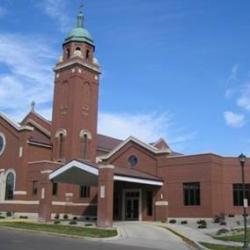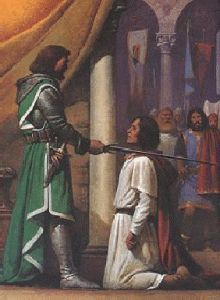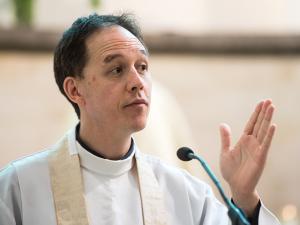
I have just completed in several posts a journey through the Mass, getting help from an imaginaery visitor from space. Imagining this fresh observer helped me see, through her eyes, things that are easy to miss for a Catholic grown perhaps too used to the sights and sounds of typical liturgies. I hope my love for those Sunday gatherings has shown through all of these posts. Now at the end of the journey I want to speak lovingly as I register some complaints. They will range from the small and irksome to some rather significant issues. Most are just things I wish people or priest would do differently. A few would involve changing rubrics. One of them concerns the tabernacle.
This project will take another few posts on some other things like:
- Missalettes
- Silence
- Distributing and receiving Communion
- The Consecration and the Doxology
- Behaviors and personalities, including people, priest, and crying babies
The present post will look at three issues:
- genuflecting or bowing, the sign of reverence,
- where to place the tabernacle,
- and, as an aside, the sanctuary lamp.
Reverencing the deity present in the tabernacle
Generally we know what the tabernacle is. And we know about genuflecting in church. But do we know enough to put these two things together? Often it seems we don’t. This issue arises because the traditional placement of the tabernacle, on the big altar against the far wall of church, has changed in many churches.
We genuflect (or bow) to acknowledge the presence of deity, and that presence is symbolically and really centered in the tabernacle. That’s where consecrated but not consumed hosts remain after Mass. So if that place is somewhere else than directly in front of us when we enter church, that’s where we should face when we genuflect or bow.
Before the reform of the liturgy, people could come into church and genuflect straight ahead. Necessarily that was toward the tabernacle. Today it seems most Catholics don’t look to see where the tabernacle might be but still genuflect straight ahead. That is, when they’re not turning toward the pew and genuflecting to the people who got there first!
Older Catholics probably remember a period of education that helped introduce liturgical changes. It seems this item, where–I mean whither–to genuflect, was left out of those instructions. Younger Catholics get their instructions from the example of their elders. The result: In churches that have moved the tabernacle, most people aim this act of reverence in the wrong direction.
A liturgical wish: There’s a resurgence of interest in reverence in church, for sure among peoplel who like the old liturgy. Let’s find a way to focus on the opportunities for reverence that the new liturgy affords. That would include consciously turning toward the tabernacle before reverently bowing or genuflecting.
Where to put the tabernacle
Before the tabernacle moved, people genuflected toward it, straight ahead. Maybe we should put the tabernacle back where it was. That’s how this article in Patheos thinks and several other articles you can easily find. They all present reasons for putting the tabernacle back front and center. Unfortunately, they ignore the reasons for putting the tabernacle somewhere else. These reasons concern the relative importance of tabernacle and altar and the clarity with which these symbols present themselves.
Outside of Mass, the most important of the church’s furnishings is the tabernacle. During Mass that primacy belongs to the altar. As Mass begins, ministers bow to the altar, not the tabernacle. Incensing on high occasions honors the altar, the ministers, and the people, but not the tabernacle. You can have a Mass without a place to reserve the Eucharistic elements, but you need an altar.
If the altar and the tabernacle are in a direct line from the assembly’s viewpoint, these symbols conflict. You can think them separately, of course, but you see them together. While liturgy offers plenty for the mind to think, its power, humanly speaking, comes from its appeal to the senses.
Altar and tabernacle symbolize different things; they occupy different places in the worshiper’s piety. They ought to be in visually separate places in church. At Mass one’s attention should be on the symbols relevant to Mass—presider’s chair, ambo for the Liturgy of the Word, and altar.
On the other hand, when one comes to church to be with Jesus in the Blessed Sacrament, one ought to be able to focus on the great symbol of that presence alone. That’s another reason for locating the tabernacle prominently but to one side. In most cases this placement will also facilitate the worshiper’s closer approach to the Presence.
The Sanctuary Lamp
Related to the presence of Jesus in the tabernacle is the sanctuary lamp. But the sanctuary lamp could be–I think should be–about more. Even its name suggests it honors the whole sanctuary. Further than that, the concept of sanctuary can extend to more than the area where specially designated ministers perform their functions. Protestants mean by “sanctuary” the entire space where people come for liturgy. Catholic terminology divides the place where ministers function (“sanctuary”) from the place where the rest of the people gather (“Nave”). I see no good reason for this separation.
In many Catholic churches the location of the sanctuary lamp supports the Protestant’s idea of the worship space. It’s placed near enough to the tabernacle so that it honors the divine Presence there. But its location shows that it shines also for the entire space where worship happens, the whole “sanctuary” as Protestants conceive it.
Another liturgical wish: This newer placement of the sanctuary lamp is a praiseworthy development in Catholic church architecture. I hope it leads to development in Catholic thinking. The space where the People of God gather and worship is one holy place, a sanctuary. It’s where the one act of worship in which ministers and the whole assembly partake happens.
Image credit: St. Magdalen de Pazzi, via Google Images












